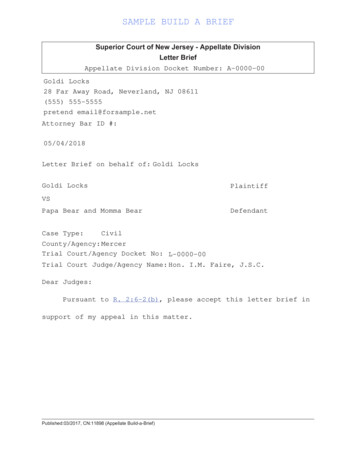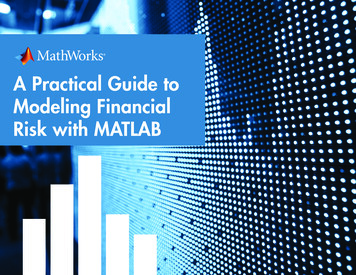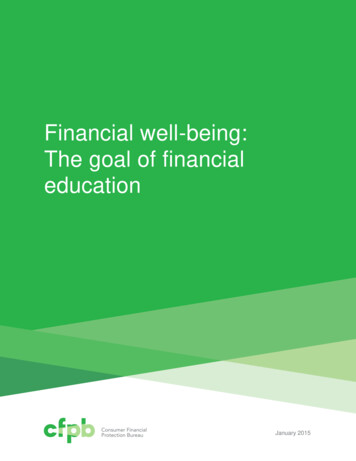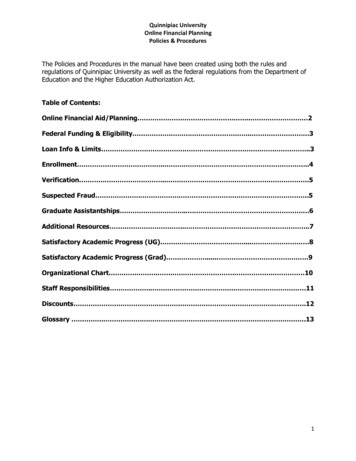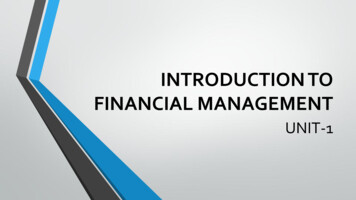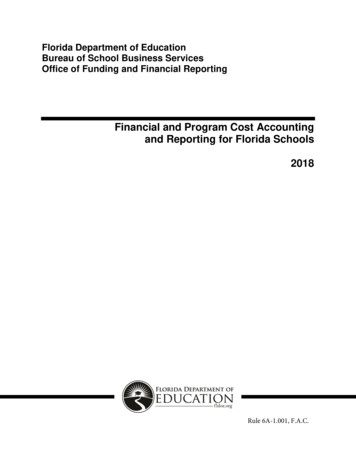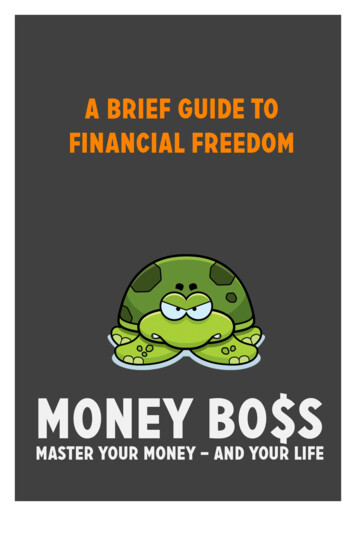
Transcription
A Brief Guide toFinancial Freedomby J.D. RothDedicated to a decade of Get Rich Slowly readers —and to the future readers of Money Boss.Copyright 2016 by J.D. RothAlthough I retain copyright on this material, you’re free to redistribute it as long as you don’t modify it or claim it as your own.
contentsIntroduction — page 1Who is J.D. Roth? Like father, like son Becoming boss of my own life Becoming boss of your lifeChapter one: Be the Boss — page 6Calculating net worthChapter two: Know Your Mission — page 9A man with a plan What’s your why? Your personal mission statementChapter three: Tap the Power of Profit — page 15The most important number in personal finance Profit is power Computing your profit marginChapter four: Save Big — page 20Lifestyles of the rich and fameless The magic of thinking bigChapter five: Earn More — page 27The more you learn, the more you earn Work more. Work better. Sell yourself You are 100% responsible for your incomeChapter six: Think like a billionaire — page 34The magic of compounding The wealth snowball Mindful spendingChapter seven: Invest Simply — page 39The worst investor I’ve ever known The Money Boss investment philosophy The Money Boss investment strategyChapter eight: Do the right thing — page 46The power of barriers and pre-commitment Do the right thing – automagicallyChapter nine: Build a Wealth Snowball — page 51Your wealth snowball The crossover pointChapter Ten: Six Degrees of Financial Freedom — page 57The Money Boss method in real life The six stages of financial freedomAppendix A: Get Out of Debt — page 64Why debt sucks The debt snowball Building a better snowball
A Brief Guide to Financial FreedomIntroductionFor many, money is a mystery. It’s not the numbers that are complicated –the math behind wealth-building is shockingly simple – but it’s the mentalbaggage that bogs us down: the psychology, the emotions, the discipline,the peer pressure.While the majority of Americans struggle with their personalfinances, the basics of business are baked into our national subconscious.We all get that in order to survive and thrive, a company has to makemoney. What most people fail to grasp, however, is that the same conceptholds true for household finances.I want to change that.This brief guide to financial freedom has one goal: To teachyou the fundamentals of financial independence.If you implement the ideas in this book, you will build wealth. Butthis is no “get rich quick” scheme. These concepts are time-tested (andmath-tested) methods for managing money. They’re the very sametechniques that quiet millionaires have been using for generations toaccumulate cash and retire early.Before we begin, let me give you a bit of background.Who is J.D. Roth?My name is J.D. Roth. For a decade, I've been reading and writing aboutpersonal finance. Today I'm financially independent, but ten years ago mymoney life was a disaster.In 2004, I had over 35,000 in consumer debt — credit-cardbalances, personal loans, a car payment — and was living paycheck topaycheck on a salary of 50,000 per year. I spent every penny I earned andhad no savings. Naturally, I decided to buy a new house. And that was thefinal straw.1
A Brief Guide to Financial FreedomI was flooded with financial obligations. I felt like I was drowning.All I wanted to do was bury my head in the sand, to play computer gamesand read comic books. I wanted to give up. Instead, I stopped shirkingresponsibility, buckled down, and got to work. Using skills I'd learned as asmall-business owner, I began to methodically eliminate my debt.What do I mean when I say I'm financially independent? I mean that Ihave enough money saved and invested to fund my current lifestyleindefinitely. I enjoy financial freedom. This manual is all about howyou too can achieve financial independence.Like Father, Like SonYou see, my father was a serial entrepreneur: He was always startingbusinesses. Most failed, but some were wildly successful.As a boy, I imitated him by starting kid-sized businesses of myown. My ventures were much smaller than Dad's, but they had similar upsand downs. The lemonade stand by the side of the road failed miserably,but I made a tidy profit re-selling used books and baseball cards to myfriends. I made even more money by marketing a homemade comic bookat the school store.After college, I took ajob as salesman at the familybox-making factory. When Daddied in 1995, my brothers and Iwere forced to learn quickly howto manage every aspect of thecompany, from payroll topurchasing, from marketing toproduct design. Then, in 1998, Istarted a computer-consultingcompany to make money in myspare time.As both businesses grew,I noticed something odd. Mypersonal finances were a mess —I spent compulsively and wasdeep in debt — but when Imanaged money for thecompanies, I had a completely different mindset. I was careful, almost2
A Brief Guide to Financial Freedomparsimonious. This was partly to appease the IRS, but it was also a pointof pride. Maybe I couldn't take care of my personal finances, but I wasdamn well going to run a ship-tight business!I turned business management into a game. I imagined I was theChief Financial Officer (CFO) of a Fortune 500 firm. Even when myconsulting company was making less than 5000 per year, I challengedmyself to make the best possible decisions. It worked. Even as my personalfinances remained mired in muck, both businesses grew and prospered.Becoming Boss of My LifeOne night in October 2004, after I'd bounced yet another check andmissed yet another payment, I reached rock bottom. I began to wonderwhy I didn't use my entrepreneurial skills at home. What if I madedecisions in my personal life as if I were making them for a business?What if I installed myself as CFO of JD, Inc? How would I cut costs? Howwould I increase revenue? Where were the best places for me to direct mycash flow?That night, I drafted a three-year plan to get out of debt.According to my calculations, I could pay off everything I owed byDecember 2007 — if I managed my money wisely. I decided to give it ashot.I cut back on spending. I boosted my income. As JD, Inc. becameprofitable and my cash flow improved, I paid down debt. I tracked myspending and created monthly reports to document my progress.The results were remarkable.In less than a year, I had set aside a 5000 emergency fund andhad increased my cash flow by 750 per month. I plowed that “profit” intodebt-reduction. I continued to manage my life as a business, and inDecember 2007 — right on schedule! — I became debt-free for the firsttime in my adult life.Today, nearly a decade later, I still manage my life as a business.Because I'm human, I sometimes make mistakes — occasionally I makedumb mistakes — and some years are more profitable than others.Through it all, I do my best to treat my money as if it belonged to acorporation and not to me. I believe my most important work is as CFOof JD, Inc.And I believe that your most important work is the as CFO ofYou, Inc.3
A Brief Guide to Financial FreedomAs I dug out of debt and built wealth, I wrote about my experience at ablog called Get Rich Slowly. I shared the things that worked — and thethings that didn't. The site grew and prospered.I sold GRS in 2009 and began writing about money for otheroutlets. I published Your Money: The Missing Manual in 2010. For fouryears, I wrote the "Your Money" column in Entrepreneur magazine.Then, in 2014, I released the year-long Get Rich Slowly course.This book (and the Money Boss blog) builds on all of theseprojects, and is my attempt to provide a unified, cohesive philosophyto help others achieve financial independence.Becoming Boss of Your LifeThis guide is different than most of the personal finance books and blogsyou've read.Instead of assuming you're a victim of circumstance, Iassume that you are the master of your own fate. Sure, you're a part ofthe overall economy and subject to both lucky and unlucky breaks, butultimately you're in charge. Your circumstances may not be your fault, butthey're your responsibility. You are the boss of your own life.I won't pretend that you can meet your goals without doing thework. Some books would have you believe that you can get rich quicklywith minimal effort. Gold! Passive income! Think and grow rich! Clipcoupons until you have a million dollars! It doesn't work like that.Running a profitable business is hard work; managing the affairs of You,Inc. successfully may be the hardest work of all.Still, I'll show steps you can take to boost profit quickly — ifyou've got the guts. You need a budget. You need to spend less than youearn. To have any chance of achieving your dreams while you're stillyoung, you'll have to spend a lot less than you earn. That means cuttingcosts on transportation and housing while boosting your income in anyway possible.But I'll help you see that these choices don't have to be tortuous.I'll stress the power of purpose. Most personal finance advice skips thisimportant step. The financial gurus will tell you how to scrimp and save,but they somehow forget to mention the why. When you have a why,you can bear almost any how because you understand that when you optto save for the future instead of spending on today, you're not making asacrifice. You're choosing to buy your future freedom.4
A Brief Guide to Financial FreedomWhether you hope to escape the chains of debt, to save for a oneyear sabbatical, or to retire within a decade, you can have the financialfreedom you desire — if you're willing to accept the role andresponsibilities as boss of your own life.Your motto must be, “The buck stops here!”Don't blame anyone or anything else for your financial situation,and don't expect somebody else to rescue you. Your circumstances mightnot be your fault, but they're your responsibility. Your financial fate restsin your hands.Let's get started!5
A Brief Guide to Financial FreedomChapter OneBe the BossHere's the fundamental premise of my philosophy: You should manageyour personal finances the way a business owner would manage hers.To illustrate why I think this is so important, let me introduce youto my friend Harlan.When he was 25, Harlan's world fell apart. In a matter of weeks,his girlfriend left, he lost hisjob, his car was impounded,and he was evicted from hisapartment. When he movedback in with his dad, heknew he'd hit rock bottom.While looking forwork, Harlan did some soulsearching. He realized thatfor too long, he'd beenletting life happen to him.He'd been letting otherpeople and outside eventscontrol his destiny. Heblamed his situation on the economy, on his boss, on his girlfriend – onplain old bad luck. He blamed everyone but himself.But blaming others only left him feeling helpless.Slowly at first, Harlan changed his mindset. He decided thatfailure or success was in his hands. He made it his mission to improve hislife and his finances.6
A Brief Guide to Financial FreedomHe moved to a new apartment, which he shared with threeroommates. His rent was less than 350 per month and other expenseswere split four ways.He found a new, higher-paying job as assistant to the ChiefOperating Officer in a division of a large financial firm.Most importantly, Harlan began to actively manage his money.He tracked every penny he spent. He opened a savings account and beganto save for retirement.In short, Harlan took control of his life. He chose when (and why)to get out of bed in the morning. He decided how well he did the work hisboss assigned him. He chose whether or not he was happy.every secondof the day. He was calling the shots – all of them.As part of his new job, Harlan got a glimpse at how big businessesoperate. He saw what made them profitable, and he saw what made themfail. He decided to apply some of these business lessons to his own life.For instance, because he'd been producing financial reports for adivision of his company, he started creating financial reports for hispersonal accounts. At first, these reports were embarrassing. Theyrevealed just how poorly he had managed his money. But Harlan foundthat running the reports kept him motivated. They were a way to "keepscore" on his progress.Harlan has made a lot of progress. After nearly fifteen years as amoney boss, he's gone from deadbeat to hustler. He's now financiallyindependent. (Yet he still treats his personal budget like a business.)Calculating Net WorthMy goal is to teach you how to run your life like a business. I want you toearn enormous profits so that you can use the money to do whatever it isyou dream of doing. But just as Harlan and I had to start at the verybeginning, you will too.Before we can begin, however, I have a task for you. I want you totake a snapshot of your current financial position by calculating your networth. I’ll explain how.To measure the value of a business, companies talk about equityor "book value". Jargon, right? In personal finance, equity is known as networth. It's exactly the same thing but on a personal level. Your net worthis an important number because it reveals how much the business of you isworth at the moment.Still clear as mud? Maybe this definition of net worth from theblog Wait But Why will make more sense:7
A Brief Guide to Financial Freedom“What would happen if you sold everything you own, liquidated anyinvestments you have, paid off all of your debts, and withdrew whatevercash you have in bank accounts? You’d be standing on the street naked,with nowhere to go, holding a bunch of cash, and people would belooking at you. And whatever cash you were holding would be your networth.”Net worth tracks your financial health in the same way that weightmeasures your fitness. Neither number tells the whole story, but as ameasure of change over time each is a handy tool.Calculating net worth is easy. It's what you own minus what youowe. That's it. Simple, right? Here’s how to calculate your own net worth:1. List your assets. Check all of your bank accounts and note theirbalances. If you have investment and/or retirement accounts,write down how much you have in them. If you own your home,use Zillow to determine its current value. If you own a car, useKelley Blue Book to figure out how much it's worth. Add all ofthese together to find the total value of your assets.2. Next, list your liabilities. Write down how much you owe on yourcar, the current balance of your mortgage, how much you haveleft on your student loans. Record the balance of each credit cardand personal loan. The sum of everything you owe representsyour total liabilities.3. Subtract what you owe from what you own. Your net worth is yourassets minus your liabilities.To make things even easier, I've created a net worth spreadsheet inGoogle Docs for you to download or copy: tinyurl.com/MBnetworth.(Copy and paste that URL into your browser to get the template.)Once you've calculated your net worth, write this number down.Burn it onto your brain. I want you to remember how much you're worthtoday so that we can see the progress you've made in six months. And ayear. And ten years. As the business of you begins to make a profit, yournet worth will grow.8
A Brief Guide to Financial FreedomChapter TwoKnow your missionWhat do you want out of life?Maybe that seems like a strange question in a book aboutfinancial freedom. What have goals to do with becoming a money boss?Everything! Having a personal mission is key to running your life likea business. Your goals help you decide how to spend your time andmoney.When I think about the difference between people with purposeand people without, I always think of my friend Paul.Twenty years ago, as I was swimming in self-induced debt, Paul was livinga bare-bones lifestyle that seemed ridiculous to me. He didn't own a9
A Brief Guide to Financial Freedomtelevision. He had few books and little furniture. His only indulgenceseemed to be a collection of bootleg U2 albums."How can you live like this?" I asked him during one visit."Where's all of your Stuff?"He shrugged. "I don't need a lot of Stuff, J.D. Stuff isn't important.It gets in the way of the things I really want."I didn't know what he meant. To me, life was all about the Stuff. Ihad hundreds of CDs and thousands of books. I had a TV, a stereo, ahouse, and a car. I wanted more.Paul didn't have any of these, but he had things I didn't have. Hehad happiness. He had freedom. He had money. He had goals.A Man with a PlanAt the time, I earned at least twice Paul's income, but he had money in thebank while I had none. I couldn't see the connection between Paul'schoices and his financial success. And I couldn't see the connectionbetween my spending and my mounting debt. I was blind.One day, Paul and I went for a hike. As we walked, he told mewhat he'd been up to. He was living in a small town in northernWashington, working two full-time jobs and a part-time job. He got freerent in exchange for housesitting with an elderly homeowner. "I've onlyhad five or six days off in the past eight months," Paul told me."That's insane!" I said. "Why would you do that to yourself?"Paul smiled. "I have a plan," he said. "I want see the world. I'mgoing to buy a one-way ticket to Thailand. I'm just going to go. I'll travelfor as long as my money holds out. The more I work, the longer I'll be ableto stay on the road."I heard what he was saying, but I didn't really understand."Do you want to come with me?" Paul asked. Of course I did, but Icouldn't. I was in debt. I had no savings. I couldn't afford to leave work fora few days, let alone a few months. How would I pay for all of my Stuff?Paul went on his trip. He backpacked across Europe and Asia, andhe loved it. He sent me postcards from Thailand and India, from Nepaland Israel and Jordan. He was gone for five months. Then, because he'dbuilt his life around this goal, he returned to a financial position similar tothe one he'd left.Back in Oregon, Paul settled down to a more "normal" way of life.He got a real job. He even bought a house. Still he pinched his pennies,spending only on the things that mattered most to him. In time, I began tosee the connection between his lifestyle and his quiet wealth.10
A Brief Guide to Financial FreedomHere's what Paul taught me: Have a plan so amazing, soglowing, that you're willing to walk blurry-eyed to work every day tomake the money necessary to achieve it.Paul David Carlile, 1969-2009What's Your Why?What do you want out of life?Too many people never take the time to answer this question.And of those who do answer it, a large number have only nebulous dreamsand goals. I want you to do more. Today, I want you to create a personalmission statement.To complete this exercise — which is based on the work of timemanagement guru Alan Lakein — you'll need about an hour ofuninterrupted time. You'll also need a pen, some paper, and some sort ofstopwatch.To make things easier, I've created a free PDF version of this projectfor you to download and print: tinyurl.com/MBwhyWhen you're ready, I want you to do the following:1. At the top of a blank page, write this question: What are mylifetime goals? For five minutes, list whatever comes to mind.Imagine you don't have to worry about money, now or in thefuture. What would you do with the rest of your life? Don't filteryourself. Fill the entire page, if you can. When you're finished,11
A Brief Guide to Financial Freedom2.3.4.5.spend an additional five minutes reviewing these goals. Make anychanges or additions you see fit. Before moving on, note the threegoals that seem most important to you.On a new piece of paper, write: How would I like to spend the nextfive years? Spend five minutes answering this question. Be honest.Don't list what you will do or should do, but what you'd like to do.Suspend judgment. When your time is up, again spend fiveminutes reviewing and editing your answers. As before, highlightthe three goals that most appeal to you.Start a page with the question: How would I live if I knew I'd bedead in six months? Imagine that your doctor says you'vecontracted a new disease that won't compromise your health now,but which will suddenly strike you dead in exactly six months.There is no cure. How would you spend the time you have left?What would you regret not having done? You know the drill:Take five minutes to brainstorm as many answers as possible,then five minutes to go back through and consider yourresponses. When you're ready, indicate the three things thatmatter most to you.At the top of a fourth piece of paper, write: My Most ImportantGoals. Below that, copy over the goals you marked as mostimportant from answering each of the three questions. (If anyanswers are similar, combine them into one. For instance, if "writea novel" was one of your top answers to the first question and"writing fiction" was a top answer to the second, you'd mergethese into a single goal.)The final step requires a bit of creativity. Label a fifth piece ofpaper My Mission. Look through your list of most importantgoals. Does one stand out from the others? Can you see acommon thread that connects some (or all) of the goals? Usingyour list as a starting point, draft a Mission Statement. YourMission Statement should be short — but not too short. It mightbe anywhere from a few words to a few sentences. Take as muchtime as you need to make this the best, most compellingparagraph you can write.When you've finished, I want you to set aside your Mission Statement andwalk away. Go about the rest of your life for a few days. Don't forgetabout your mission, but keep it in the back of your mind.12
A Brief Guide to Financial FreedomYour Personal Mission StatementAfter you've had time to stew on things, sit down and review what you'vewritten. How does your Mission Statement make you feel? Can youimprove upon it? You want a vision to give you a sense of purpose thatdrives you day-in and day-out, through good times and bad. Ideally,your mission will do for you what my friend Paul's did for him. It'll be soamazing, so glowing that you’re willing to walk blurry-eyed to work eachmorning to make the money necessary to reach your goal.Your Mission Statement isn't permanent. As your priorities and tasteschange, and as new opportunities present themselves, your mission willadapt and grow.What does an actual Mission Statement look like? Goodquestion! Here are personal mission statements from five famous CEOs:tinyurl.com/MB-ceo-mission. And here's mine:“I want to be the best person I can be, both mentally and physically. Iwant to sample all that the world has to offer by fostering newrelationships, exploring new ideas, and daring to try new things. I wantto use my skills and experience to improve the lives of others while alsoimproving my own.”Sound boring? Not to me! I wrote this mission several years ago, and itstill guides me today. When I set personal goals, I base them on thismission. When I make decisions about where to live and what to do withmy life, I use this mission to guide me. Bottom line: This mission shapesthe way I manage my money and my life.After you've created a Mission Statement, your next assignment— if you're willing to accept it — is to brainstorm a list of Next Actions tosupport your Mission Statement. What kinds of things can you do to helpyou achieve this goal or pursue this mission? Write down anything thatcomes to mind.When you have your list of Next Actions, pick the three you cando most quickly (these should become your short-term goals) and thethree that would have the biggest impact on your life (these shouldbecome your long-term goals). Focus on these six goals!What if you're still having trouble coming up with a mission?Don't give up. Try a different approach. Head to your public library and13
A Brief Guide to Financial Freedomborrow one of the following books, each of which has great info aboutfiguring out what to do with your life: How to Get Control of Your Time and Life by Alan LakeinThe Seven Habits of Highly Effective People by Stephen R. CoveyWishcraft: How to Get What You Really Want by Barbara SherThe Magic of Thinking Big by David SchwartzIf, after all this, you still need more help creating your Mission Statement,take a few minutes to walk through the Mission Statement Builder fromFranklinCovey (msb.franklincovey.com). It's a free online tool thattranslates your goals and values into a statement of purpose.14
A Brief Guide to Financial FreedomCHAPTER THREETap the POWER OF PROFITIn order to survive and thrive, you need to earn a profit.You already know profit is the lifeblood of every business. It's likefood and water for the human body. Although proper nutrition isn't thepurpose of life, we couldn't exist without it. Food and water give usstrength to do the stuff that matters most. So too, profit isn't necessarilythe purpose of business — but a company can't survive without it.Here's a secret: People need profit too.In personal finance, "profit" is typically called "savings". That's toobad. When people hear about savings, their eyes glaze over and theirbrains turn to mush. Bor-ing! But if you talk about profit instead, peopleget jazzed: “Of course, I want to earn a profit! Who wouldn't?”Profit is easy to calculate. It's net income, the difference betweenwhat you earn and what you spend. You can compute your profit with thissimple formula:PROFIT INCOME - EXPENSESIf you earned 4000 last month and spent 3000, you had a profit of 1000. If you earned 4000 and spent 4500, you had a loss of 500.There are only two ways a business can boost profits, and thereare only two ways you can boost personal profitability: Spend less. A business can increase profits by slashing overhead:finding new suppliers, renting cheaper office space, laying offemployees. You can increase your personal profit by spending less15
A Brief Guide to Financial Freedom on groceries, cutting cable television, or refinancing yourmortgage.Earn more. To increase revenue, a business might develop newproducts or find new ways to market its services. At home, youcould make more by working overtime, taking a second job, orselling your motorcycle.When you earn a profit, you don't have to worry about how you'll payyour bills. Profit lets you chip away at the chains of debt. Profit removesthe wall of worry and grants you control of your life. Profit frees you to dowork that you want instead of being trapped by a job you hate. When youmake a profit, you truly become the boss of your own life.With even a small surplus, the balance of power shifts in yourfavor.The Most Important Number in Personal FinanceEarlier, I asked you to calculate your net worth, the number that acts like asnapshot of your current wealth. Your net worth is the grand total of years(or decades) of profits and losses.As the authors of Your Money or Your Life put it, "[Your networth] is what you currently have to show for your lifetime income; therest is memories and illusions." Ouch!The greater the gap between your earning and spending, thefaster your net worth grows (or shrinks). This may seem obvious, butit's important. Everything you do — clipping coupons, asking for a raise,saving for a retirement — should be done to increase your profit andwealth.But profit doesn't mean much on its own. Is a 1000 monthlyprofit good or bad? Well, it depends on your circumstances.If your income is 2000 per month (or 24,000 per year), a 1000monthly profit is great. That's a saving rate of 50%. Congratulations!On the other hand, if your income is 20,000 per month (or 240,000 per year), a 1000 monthly profit gives you a saving rate of 5%.That's average at best.You see, it's not your total income that determines how wealthyyou are and will become. Nor is it your monthly surplus. No, the truemeasure of progress is your saving rate — how much you save as apercentage of your income.In business, saving rate is called profit margin. Naturally, we'regoing to call it profit margin too.16
A Brief Guide to Financial FreedomPull out your personal mission statement. Look at your goals.Your profit margin directly affects how quickly you'll achieve theseaims. A profit margin of 20% will allow you to reach your destinationtwice as quickly as a profit margin of 10%. And if you can save 40% or60%, you'll get there even quicker. (We'll talk more about how to create awealth snowball later in this book.)Profit is PowerNow I'd like you to meet myfriend Pete.Online, Pete is betterknown as Mr. MoneyMustache. He runs a popularwebsite – also called Mr. MoneyMustache – devoted tofinancial independence andsensible living.Pete's personal missionis to enjoy a rich life with hissmall family in a small house ina small town in Colorado. Hewants to pass his days slicing through canyons on his bicycle, buildingthings in his workshop, and sharing quiet moments with his wife and son.And Pete doesn't want to be tied to a job.Following the standard advice to save between 10% and 20% ofhis income, it would have taken decades for Pete to achieve these goals.Pete is not a patient man. He didn't want to wait decades for financialfreedom, so he deliberately pumped up his profit margin.After college, Pete and his wife worked long hours at jobs thatpaid well. They moved to a town where the cost of living was low and theycould bike anywhere they needed. They bought a modest home. TheMustache family generated a lot of revenue while keeping overhead low.As a result, Mr. and Mrs. Mustache set aside more than half oftheir combined take-home pay. After ten years with profit margins near70%, they were able to "retire". Pete was thirty years old. Now, a decadelater, he and his wife continue to pursue their mission, happily ignoringdetractors who say what they've done is impossible.The more you save — the higher your profit margin —thesooner you can have the things you really want out of life.17
A Brief Guide to Financial
Still, I'll show steps you can take to boost profit quickly — if you've got the guts. You need a budget. You need to spend less than you earn. To have any chance of achieving your dreams while you're still young, you'll have to spend a lot less than you earn. That means cutting costs on transportation and housing while boosting your income in any





